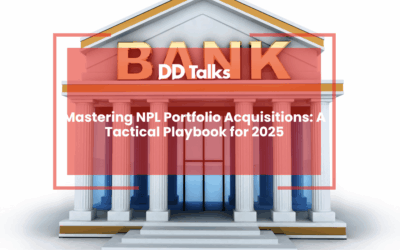Essential Insights: NPL Securitization’s Strategic Impact
- NPL securitization has evolved from simple bilateral sales to sophisticated structured transactions, with government-backed schemes like Italy’s GACS catalyzing market development.
- Capital relief trades enable banks to optimize regulatory capital while managing problematic assets, improving key metrics like CET1 ratios without necessarily removing assets from balance sheets.
- The regulatory landscape has matured with specialized frameworks acknowledging NPL transactions’ unique characteristics, including amendments to the European Securitization Regulation.
- Emerging innovations include synthetic risk transfer techniques, multi-originator platforms, and technology integration through AI and blockchain to enhance valuation accuracy and trading efficiency.
- Future growth will likely be driven by COVID-19’s impact on asset quality, continued regulatory support, technological advancement, and cross-border harmonization efforts.
As European banks continue to strengthen their balance sheets, NPL securitization represents not merely a crisis management tool but a sophisticated strategic mechanism for ongoing capital optimization and risk management in an increasingly complex financial landscape.
The Future of NPL Securitization: Trends and Innovations
The European banking landscape continues to evolve in its approach to managing non-performing loans (NPLs). Despite significant progress in reducing NPL volumes since the 2008 financial crisis, European banks still hold substantial portfolios of distressed assets that impact their lending capacity and overall financial health. Securitization has emerged as a sophisticated mechanism for banks to efficiently manage these troubled assets, free up regulatory capital, and improve balance sheet metrics.
This comprehensive analysis explores the current state and future trajectory of NPL securitization in Europe, examining the fundamental structures, regulatory frameworks, and innovative approaches that are reshaping how financial institutions handle distressed debt. As European banks continue to face pressure to strengthen their balance sheets, understanding these mechanisms becomes increasingly important for stakeholders across the financial ecosystem.
Table of Contents
- Understanding NPL Securitization: Fundamentals and Mechanics
- The Evolution of Distressed Debt Securitization in Europe
- How Do NPL Capital Relief Trades Transform Bank Balance Sheets?
- Key Benefits and Challenges of NPL ABS Structures
- Regulatory Framework: How NPL Securitization is Governed in Europe
- Emerging Innovations in NPL Risk Transfer Techniques
- Case Studies: Successful NPL Securitization Transactions
- Future Outlook: Where is NPL Securitization Heading?
Understanding NPL Securitization: Fundamentals and Mechanics
NPL securitization represents a sophisticated financial engineering process that transforms illiquid non-performing loans into tradable securities. At its core, this process involves pooling diverse NPL assets, structuring them into tranches with varying risk-return profiles, and selling these securities to investors with different risk appetites.
The mechanics typically involve establishing a Special Purpose Vehicle (SPV) that purchases the NPL portfolio from the originating bank. This portfolio is then segmented into different tranches – commonly senior, mezzanine, and junior (equity) – each carrying different levels of risk and potential returns. Senior tranches receive priority in payment streams and offer lower yields with reduced risk, while junior tranches absorb initial losses but offer higher potential returns.
What distinguishes NPL securitization from standard securitization is the underlying asset quality. The distressed nature of these loans necessitates specialized valuation methodologies, enhanced due diligence, and often the involvement of dedicated servicers who specialize in NPL recovery. These servicers play a crucial role in maximizing the recovery value of the underlying assets, directly impacting the performance of the securitized notes.
Two primary structures dominate the NPL securitization landscape: true sale securitizations, where NPLs are physically transferred to the SPV, and synthetic securitizations, where only the credit risk is transferred while the assets remain on the bank’s balance sheet. Each approach offers distinct advantages depending on the bank’s strategic objectives, regulatory considerations, and market conditions.
The Evolution of Distressed Debt Securitization in Europe
The European NPL securitization market has undergone significant transformation since the global financial crisis. Initially, NPL transactions were predominantly bilateral sales to specialized distressed debt investors. However, as NPL volumes surged across Southern European markets particularly, more sophisticated approaches became necessary to address the scale of the problem.
Italy pioneered large-scale NPL securitization with the introduction of the GACS (Garanzia Cartolarizzazione Sofferenze) scheme in 2016, providing state guarantees for senior tranches of NPL securitizations. This government-backed programme catalysed market development by enhancing investor confidence and establishing standardised structures. The success of the Italian model inspired similar initiatives in Greece with the Hercules Asset Protection Scheme and in Portugal with FMSA.
The market has evolved from primarily real estate-backed NPLs to encompass more diverse asset classes, including unsecured consumer debt, SME loans, and more complex corporate exposures. This diversification has attracted a broader investor base, from specialized distressed debt funds to institutional investors seeking yield in a low-interest-rate environment.
Recent years have witnessed increasing standardisation in documentation, valuation methodologies, and reporting frameworks, contributing to greater market efficiency and liquidity. The securitisation concepts applied to NPLs have become increasingly sophisticated, with innovative structures emerging to address specific challenges in different jurisdictions and asset classes.
How Do NPL Capital Relief Trades Transform Bank Balance Sheets?
NPL capital relief trades represent a strategic approach for banks to optimise their regulatory capital while managing problematic assets. These transactions enable banks to transfer the credit risk associated with NPL portfolios to third-party investors without necessarily removing the assets from their balance sheets, particularly in synthetic structures.
The mechanics of these trades typically involve banks retaining the senior tranches while selling mezzanine and junior tranches to investors. By transferring the riskiest portions of their NPL portfolios, banks can achieve significant risk-weighted asset (RWA) reduction, improving key regulatory ratios such as the Common Equity Tier 1 (CET1) ratio. This capital relief creates headroom for new lending activities, potentially stimulating economic growth.
From an accounting perspective, these transactions can also help banks reduce provisions and improve profitability metrics. By moving NPLs off the balance sheet or transferring their risk, banks can potentially release excess provisions, boosting their profit and loss statements. This accounting benefit, combined with regulatory capital relief, makes these transactions particularly attractive for banks under pressure to improve performance indicators.
The transformation extends beyond numerical improvements. By actively managing NPL exposures, banks signal to regulators, rating agencies, and investors their commitment to addressing asset quality issues. This can lead to improved funding costs, enhanced market perception, and greater operational focus on core banking activities rather than distressed debt management.
Key Benefits and Challenges of NPL ABS Structures
NPL Asset-Backed Securities (ABS) structures offer numerous advantages to originating banks. Primarily, they provide an efficient mechanism for balance sheet cleanup without requiring substantial upfront capital for provisions. By transferring NPLs to investors with appropriate risk appetites and recovery expertise, banks can focus on core lending activities while potentially maintaining some upside through retained interests.
For investors, NPL ABS presents opportunities to access diversified pools of distressed assets with structured risk profiles that match their investment criteria. The tranched structure allows for participation across the risk spectrum, from conservative institutional investors seeking stable returns from senior tranches to specialised distressed debt funds pursuing higher yields through junior positions.
However, significant challenges persist. Valuation complexity remains a primary obstacle, with information asymmetry between sellers and buyers often creating a “pricing gap.” Accurate forecasting of recovery timelines and amounts requires sophisticated modelling and deep market expertise, particularly given the heterogeneous nature of many NPL portfolios.
Legal and operational hurdles also complicate NPL securitizations. Varying foreclosure procedures, debtor protection laws, and court efficiency across European jurisdictions create additional complexity and uncertainty. The servicing infrastructure required to manage NPL portfolios effectively represents another challenge, as successful recovery often depends on specialised servicing capabilities that may not be readily available in all markets.
Regulatory uncertainty continues to influence market development, with evolving capital requirements, accounting standards, and disclosure obligations creating compliance challenges for both originators and investors. Navigating this complex regulatory landscape requires significant expertise and resources, potentially limiting market participation.
Regulatory Framework: How NPL Securitization is Governed in Europe
The regulatory landscape for NPL securitization in Europe has evolved significantly, reflecting policymakers’ dual objectives of promoting financial stability while facilitating NPL resolution. The European Securitization Regulation (EU) 2017/2402, implemented in 2019, established a comprehensive framework for all securitizations, including those involving non-performing exposures.
This regulation introduced the concept of Simple, Transparent and Standardised (STS) securitizations, though initially, NPL transactions struggled to meet these criteria due to their inherent complexity. Recognising this challenge, the European Commission introduced amendments specifically addressing NPL securitizations in 2021, creating a specialised framework that acknowledges their unique characteristics while maintaining robust investor protection measures.
The European Banking Authority (EBA) has played a pivotal role in developing technical standards and guidelines for NPL transactions. Their guidance on NPL management, disclosure requirements, and risk transfer assessment has helped standardise market practices and increase transparency. Additionally, the ECB’s guidance on NPL management has established clear expectations for banks regarding NPL reduction strategies, indirectly influencing securitization activities.
National regulatory frameworks continue to influence NPL securitization markets, with countries like Italy, Greece, and Spain implementing specific legislation to facilitate NPL resolution. These national initiatives often include tax incentives, streamlined foreclosure procedures, or state guarantee schemes designed to overcome jurisdiction-specific barriers to NPL transactions.
Accounting standards, particularly IFRS 9, have significant implications for NPL securitizations. The interaction between accounting derecognition criteria and regulatory capital treatment creates complex considerations for transaction structuring, often requiring careful balance between accounting, regulatory, and economic objectives.
Emerging Innovations in NPL Risk Transfer Techniques
The NPL securitization market continues to evolve with innovative structures designed to address specific challenges and optimise outcomes for both originators and investors. Synthetic risk transfer techniques have gained prominence, allowing banks to achieve regulatory capital relief while retaining the assets on balance sheet. These structures often involve credit default swaps or financial guarantees rather than true asset sales, offering flexibility and potentially reducing execution complexity.
Multi-originator platforms represent another significant innovation, enabling smaller banks to achieve economies of scale by pooling their NPL portfolios. These collaborative approaches help overcome minimum size thresholds that might otherwise prevent smaller institutions from accessing securitization markets effectively. By standardising documentation and sharing due diligence costs, these platforms can significantly improve economic viability for participants.
Technology is increasingly transforming NPL management and securitization processes. Advanced data analytics and artificial intelligence are enhancing portfolio valuation accuracy, improving recovery forecasting, and enabling more granular risk assessment. Blockchain technology is being explored for its potential to improve transparency, streamline documentation, and create more efficient trading mechanisms for NPL securities.
ESG considerations are beginning to influence NPL securitization structures, particularly regarding the social impact of recovery strategies. Innovative approaches that incorporate borrower rehabilitation programmes or socially responsible collection practices are emerging, potentially creating value through improved recovery rates while addressing broader societal concerns about distressed debt management.
Public-private partnerships continue to evolve, with governments and supranational institutions developing increasingly sophisticated mechanisms to support NPL resolution. These range from guarantee schemes to co-investment platforms where public entities provide catalytic capital to attract private investment into challenging NPL markets.
Case Studies: Successful NPL Securitization Transactions
The Italian market provides several instructive examples of successful NPL securitizations. The “Siena NPL 2018” transaction by Monte dei Paschi di Siena represented a landmark €24.1 billion securitization supported by the GACS scheme. This transaction demonstrated how state guarantees could effectively bridge valuation gaps and facilitate large-scale NPL resolution. The senior tranche received investment-grade ratings due to the government guarantee, attracting institutional investors who might otherwise have avoided the NPL market.
In Spain, Project Hercules by Banco Sabadell illustrated the effective use of synthetic securitization structures for NPL risk transfer. This transaction involved a €2.7 billion portfolio of NPLs and foreclosed real estate assets, with the bank retaining the assets on balance sheet while transferring significant risk to investors through a synthetic structure. This approach allowed the bank to achieve regulatory capital relief while maintaining operational control over the workout process.
Greece’s “Project Galaxy” by Alpha Bank demonstrated how securitization can be combined with servicing platform creation to maximise value. This €10.8 billion transaction involved not only the securitization of NPLs but also the establishment of a dedicated servicing entity with specialized recovery expertise. This integrated approach addressed one of the key challenges in the Greek market – limited servicing infrastructure – while creating a sustainable mechanism for ongoing NPL management.
In Portugal, Novo Banco’s “Project Nata II” showcased how securitization can be used as part of a broader resolution strategy for a troubled bank. This transaction involved a €3 billion portfolio of corporate NPLs and was structured to optimise both immediate capital relief and long-term recovery value, demonstrating the flexibility of securitization structures to address complex resolution scenarios.
Future Outlook: Where is NPL Securitization Heading?
The future of NPL securitization in Europe appears poised for continued evolution, influenced by several key trends. The COVID-19 pandemic has created expectations of a new wave of NPLs across European banking systems, potentially driving increased securitization activity as banks proactively address emerging asset quality challenges. However, unlike previous cycles, banks are entering this period with stronger capital positions and more sophisticated NPL management capabilities.
Regulatory developments will continue to shape market dynamics. The European Commission’s Action Plan on NPLs emphasizes securitization as a key tool for NPL resolution, suggesting continued policy support for these transactions. The ongoing refinement of the securitization framework, particularly regarding capital requirements for NPL investors, will influence market economics and participant behaviour.
Technological advancement will likely accelerate, with artificial intelligence and machine learning increasingly applied to portfolio valuation, recovery forecasting, and servicing optimization. Digital platforms may emerge to streamline NPL trading and securitization processes, potentially reducing transaction costs and expanding market access to a broader range of participants.
Cross-border harmonization efforts may gain momentum, addressing one of the persistent challenges in European NPL markets. Initiatives to standardize insolvency frameworks, foreclosure procedures, and data reporting could significantly enhance market efficiency and investor confidence, particularly for transactions involving assets across multiple jurisdictions.
The investor base for NPL securitizations is likely to broaden, with mainstream institutional investors increasingly participating alongside specialized distressed debt funds. As structures become more standardized and track records more established, NPL securities may gradually transition from alternative investments to more conventional fixed-income assets for certain investor categories.
In conclusion, NPL securitization represents a sophisticated and evolving mechanism for European banks to address asset quality challenges while optimizing capital efficiency. As market practices mature and regulatory frameworks stabilize, these structures will likely play an increasingly important role in maintaining banking system resilience and supporting economic recovery across Europe.
Frequently Asked Questions
What is NPL securitization and how does it work?
NPL securitization is a financial process that transforms non-performing loans into tradable securities. It works by pooling NPLs into a Special Purpose Vehicle (SPV), structuring them into different risk-based tranches (senior, mezzanine, and junior), and selling these securities to investors. The process typically involves specialized servicers who manage loan recovery, with senior tranches receiving payment priority but lower yields, while junior tranches absorb initial losses but offer higher potential returns.
What are the main benefits of NPL securitization for banks?
The key benefits of NPL securitization for banks include: regulatory capital relief, balance sheet cleanup without requiring substantial upfront provisions, improved financial ratios (like CET1), enhanced market perception, reduced funding costs, and the ability to refocus on core lending activities. Additionally, banks may maintain some upside potential through retained interests while transferring risk to investors with appropriate risk appetites.
How does NPL securitization differ from standard securitization?
NPL securitization differs from standard securitization primarily in the quality of underlying assets. NPL securitizations involve distressed loans requiring specialized valuation methodologies, enhanced due diligence, and dedicated servicers with recovery expertise. They typically feature more complex structures to address recovery uncertainty, often include state guarantees (like Italy’s GACS scheme), and are subject to specific regulatory frameworks designed for distressed assets rather than performing loans.
What are the main regulatory frameworks governing NPL securitization in Europe?
The main regulatory frameworks governing NPL securitization in Europe include the European Securitization Regulation (EU) 2017/2402 with its 2021 amendments specifically addressing NPLs, the European Banking Authority’s technical standards and guidelines, the ECB’s guidance on NPL management, and country-specific legislation (like Italy’s GACS scheme, Greece’s Hercules Asset Protection Scheme, and similar frameworks in Spain and Portugal). These are complemented by accounting standards like IFRS 9 that impact transaction structuring.
What innovations are emerging in NPL securitization?
Emerging innovations in NPL securitization include synthetic risk transfer techniques using credit default swaps rather than true asset sales, multi-originator platforms enabling smaller banks to achieve scale, advanced data analytics and AI for improved valuation and recovery forecasting, blockchain technology for enhanced transparency and trading efficiency, ESG-focused structures incorporating socially responsible collection practices, and evolving public-private partnerships with governments providing catalytic capital or guarantees.
What challenges do NPL securitizations face in the European market?
NPL securitizations in Europe face several challenges including: valuation complexity and information asymmetry creating pricing gaps, varying foreclosure procedures and debtor protection laws across jurisdictions, limited specialized servicing infrastructure in some markets, regulatory uncertainty with evolving capital requirements and accounting standards, and the heterogeneous nature of NPL portfolios requiring sophisticated modeling. These factors can increase transaction complexity and potentially limit market participation.
How might the NPL securitization market evolve following the COVID-19 pandemic?
Post-COVID, the NPL securitization market is likely to see increased activity as banks address new waves of distressed assets, but with more sophisticated approaches than previous cycles. Expected developments include continued regulatory support through the European Commission’s Action Plan on NPLs, accelerated technological adoption for valuation and servicing, greater cross-border harmonization of insolvency frameworks, expansion of the investor base beyond specialized distressed debt funds, and more standardized structures that could transition NPL securities from alternative investments to more conventional fixed-income assets.




0 Comments